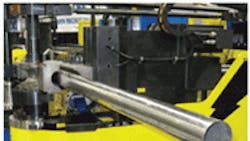Robotics in bending
The bending of pipe and metal plates into useful shapes is increasingly automated by robotics. Recall that just a few years ago, Kuka Robotics Corp., Clinton Township, Mich., announced the successful setup of twin KR500 robots used in tandem to grip and sweep plates weighing as much as 1,000 kg into press brakes to be edge-worked, bent, and flanged. Other plate-bending applications with uncomplicated paths are also improving with simple robotics and mechanical components: Dual LinearBeam push-pull mechanical actuators from Serapid Inc., Sterling Heights, Mich., now operate in manipulators from Pacific Press Technologies, Mt. Carmel, Ill., to position plates into press brakes. The manipulator moves steel plates weighing as much as 5,000 lb along 100 in. of travel through a press brake to be bent at 15 ft/min., once every 10 minutes. The push-pull actuators halve manual labor, and quadruple productivity: Previously, two people manually pushed plates through the press brake.
In addition, much like packaging applications (see article, Motors replace pneumatics in this issue) robotic bending setups are undergoing electromechanical replacement of pneumatic parts. Unison Ltd., Madera, Calif., makes an all-electric tube bender with an integrated cutter for automated single-step manufacturing of volume parts such as exhausts and tubing or piping shapes. The machine's servomotor-controlled architecture also allows programmable part-fabrication cycles: The position and force of tube-bending die are controlled, as is the movement profile and torque applied during the nick-and-shear cutting cycle. Servomotor control of cutting positions maintains accuracy and repeatability from batch to batch, to within ±0.004 in., as tubing remains under control of high-resolution digital motion architecture throughout the operation. All-electric motion control is also quieter and more efficient than traditional (hydraulically actuated) machinery.
After bending, moving the tube to the shear-tool position and making the cut takes 12 to 15 sec, compared with 60 sec for a traditional setup — plus skilled labor for handling, loading, setup, and cutoff when the same task is performed at a separate station. Finally, Unison's machine allows manufacture of multiple parts from a given length of tubing.
Breeze-Blade machines are offered through Horn Machine Tools Inc. Call (559) 431-4131 or visit hornmachinetools.com. For push-pull mechanical actuator information, visit serapid.com or call (800) 663-4514.
